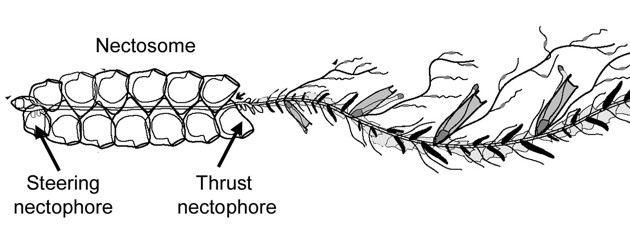The creature is Nanomia bijuga. It’s a translucent, gelatinous blob with no brain and very simple muscles. And yet, it is clearly an excellent swimmer.

In the GIF, above, a scientist injects fluorescent dye in front of it to highlight its movements. Look at its twists, its turns, its sudden changes in direction. “They are amazingly maneuverable,” says Jack Costello from the Marine Biological Laboratory in Woods Hole, Massachusetts. “They can go sideways. They can do loop the loops. They can back up.”
The secret of Nanomia’s surprising agility is teamwork. It may look like a single animal, but it’s not. It’s a siphonophore—a colonial creature that consists of many individuals, all clones of each other. There are some 175 species of them, including the infamous Portuguese man-of-war (pictured at top). Some of them are the longest animals in the world, growing up to 40 meters in length. Most of them are active swimmers, and all of them are colonial.
Despite carrying the same genes, Nanomia’s colony members perform different roles, much like the organs in your body. Those in the long tendrils that make up most of Nanomia are specialized for capturing prey, digestion, and reproduction. They form a veil of death and sex that trails for meters behind the animal.
The individuals that sit up front—the nectophores—act like engines. They shoot out jets of water that propel the whole colony along. The nectophores all branch from a central stem like a stalk of cherry tomatoes, forming an inch-long structure called the nectosome. This cluster gets larger with time, as new nectophores continually bud at its tip. But it’s not just their position that changes. Their jobs do, too.
Costello realized this by tracking the direction of the organism's jets over time. After studying high-speed videos of Nanomia, he noticed that the older nectophores are bigger and all point backwards. By consistently directing their jets behind the colony, they provide it with thrust—and lots of it. Every day, these jets drive Nanomia over hundreds of meters, the equivalent of a you running a daily marathon while towing another person behind you.
The younger nectophores provide very little thrust: they are smaller and their jets are weaker. But they also point outwards at more of an angle, and that allows them to steer the colony by firing their subtle jets to the side. If one fires gently, Nanomia veers slightly. If several on the same side fire strongly, Nanomia banks sharply.
“I always presumed that the small, immature swimming bells at the front did very little, and were just biding time until they get big,” says Casey Dunn from Brown University. “This paper shows that this is very wrong. The small bells actually act like mini bow-thrusters.”
Here, then, is a colonial animal whose living jet engines change roles as they age. The older ones deal with propulsion; the younger ones control direction. And this division of labour happens automatically, just by dint of how the colony expands and grows.

But how does the colony coordinate the actions of its members? How do the nectophores ‘decide’ which of them will fire at any given time? “We don’t know,” says Costello. There is one big clue: Nerve fibers run through the central axis of the nectosome and thread into the individual nectophores. The colony members might use their communal nervous system to coordinate their movements.
Costello thinks we may never know for sure. It’s hard enough to do neuroscience on standard laboratory animals like flies or worms, much less a small, gelatinous creature that’s hard to find and nigh-impossible to keep “healthy and alive and cooperative in the laboratory,” he says. “They’re a difficult nut to crack.”
Still, whatever Nanomia is doing is clearly working for it. It lives in temperate waters all over the world, can gather in large numbers, and makes a very good living as a predator. Other siphonophores are also successful.
These creatures also challenge our notions of what counts as an “individual.” If Nanomia’s nectophores are attached to one another, and coordinate their actions through a shared nervous system, does it really make sense to speak of them as a colony of individuals, rather than as body parts of a single creature?
Yes and no. The colony certainly behaves as a single individual, and many of its individual members are so specialized that they couldn’t survive without the others. Still, each member is its own entity. In the words of Casey Dunn, “Being a siphonophore is as if you were to bud thousands of conjoined twins throughout your life, some with only legs to move everybody, others with only mouths to ingest food.”
This article was originally published at http://www.theatlantic.com/technology/archive/2015/09/living-jet-engines-colony-nanomia-siphonophore/403816/
